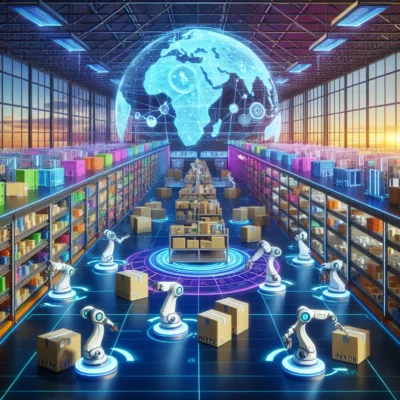Understanding AI in Supply Chain Management
Artificial Intelligence (AI) is transforming industries, and supply chain management is no exception. AI refers to the simulation of human intelligence in machines programmed to think and learn. In supply chains, AI’s relevance lies in its ability to process vast amounts of data, identify patterns, and make decisions with minimal human intervention.
Current Trends in AI Applications within Logistics
- Predictive Analytics: Leveraging AI to forecast demand and optimize inventory.
- Automation: Implementing AI-driven robots for tasks like sorting and packing.
- Route Optimization: Using AI to determine the most efficient delivery routes.
- Supplier Management: AI tools for evaluating and monitoring supplier performance.
Key Benefits of Integrating AI into Supply Chain Management
- Increased Efficiency: Automating repetitive tasks and optimizing processes.
- Cost Reduction: Lowering operational costs through better resource management.
- Enhanced Accuracy: Minimizing human errors in forecasting and inventory management.
- Improved Decision-Making: Real-time data analysis for informed decision-making.
Predictive Analytics for Demand Forecasting
Predictive analytics uses historical data, statistical algorithms, and machine learning techniques to predict future outcomes. In supply chain management, it plays a crucial role in demand forecasting.
Role in Demand Forecasting
- Data Analysis: Analyzing past sales data to predict future demand.
- Trend Identification: Recognizing patterns and trends to anticipate market changes.
- Inventory Optimization: Ensuring optimal stock levels to meet predicted demand.
Case Studies
- Walmart: Utilizes AI to predict customer demand, leading to improved inventory management and reduced stockouts.
- Amazon: Employs predictive analytics to forecast demand, optimizing their vast supply network.
Tools and Technologies
- Machine Learning Algorithms: For analyzing data and making predictions.
- Big Data Platforms: To handle and process large datasets.
- AI Software: Tools like IBM Watson and Google AI for advanced analytics.
Enhancing Inventory Management with AI
AI algorithms can significantly optimize inventory levels, reducing waste and improving efficiency.
AI Algorithms in Inventory Management
- Demand Forecasting: Predicting future inventory needs.
- Stock Replenishment: Automating the restocking process based on demand predictions.
- Waste Reduction: Identifying slow-moving items to minimize overstock.
Real-World Examples
- Zara: Uses AI to manage inventory, ensuring the right products are available at the right time.
- Procter & Gamble: Implements AI-driven systems to optimize stock levels and reduce holding costs.
Benefits
- Improved Accuracy: More precise inventory levels.
- Reduced Holding Costs: Lower costs associated with storing excess inventory.
- Enhanced Customer Satisfaction: Ensuring product availability.
Streamlining Transportation and Logistics
AI applications in transportation and logistics can lead to significant improvements in efficiency and cost reduction.
AI in Route Optimization and Fleet Management
- Route Planning: AI determines the most efficient delivery routes.
- Fleet Management: Monitoring and managing vehicle performance and maintenance.
Examples
- UPS: Uses AI to optimize delivery routes, reducing fuel consumption and delivery times.
- DHL: Implements AI for real-time tracking and dynamic route adjustments.
Real-Time Tracking and Shipment Visibility
- Tracking Systems: AI-powered systems provide real-time updates on shipment status.
- Visibility Tools: Enhanced visibility into the supply chain for better decision-making.
Supplier Relationship Management
AI can revolutionize supplier relationship management by evaluating and selecting suppliers and monitoring their performance.
Evaluating and Selecting Suppliers
- Data Analysis: AI analyzes supplier data to identify the best partners.
- Risk Assessment: Evaluating potential risks associated with suppliers.
Monitoring Supplier Performance
- Performance Metrics: Tracking key performance indicators (KPIs) to ensure compliance.
- Risk Management: Identifying and mitigating risks in the supply chain.
Case Studies
- General Electric: Uses AI to monitor supplier performance, ensuring high standards.
- Toyota: Implements AI for better collaboration and risk management with suppliers.
AI-Driven Automation in Warehousing
AI is driving significant advancements in warehouse automation and robotics.
Impact on Warehouse Automation
- Robotic Systems: AI-powered robots for sorting, picking, and packing.
- Automated Storage: Systems for efficient storage and retrieval of goods.
Examples
- Amazon Robotics: Uses AI-driven robots to automate warehouse operations.
- Ocado: Implements AI for automated picking and packing in their warehouses.
Benefits
- Increased Efficiency: Faster and more accurate warehouse operations.
- Reduced Labor Costs: Lower reliance on manual labor.
- Scalability: Easily scalable operations to meet demand.
Future Trends and Innovations
The future of AI in supply chain and logistics is promising, with emerging technologies set to revolutionize the industry.
Emerging AI Technologies
- Blockchain Integration: Enhancing transparency and security in supply chains.
- IoT Devices: Connecting devices for real-time data collection and analysis.
- Advanced Robotics: Next-generation robots for more complex tasks.
Predictions for Future Impact
- Increased Automation: Greater reliance on AI for end-to-end supply chain management.
- Enhanced Decision-Making: AI-driven insights for strategic planning.
- Sustainability: AI helping to create more sustainable supply chains.
Staying Ahead with AI Innovations
- Adoption of New Technologies: Embracing emerging AI tools and platforms.
- Continuous Learning: Keeping up-to-date with the latest AI advancements.
- Strategic Partnerships: Collaborating with AI technology providers.
Taking the First Steps with AI
Integrating AI into supply chains can seem daunting, but with the right approach, businesses can reap significant benefits.
Steps for Integration
- Assess Needs: Identify areas within the supply chain that can benefit from AI.
- Select Tools: Choose the right AI tools and technologies.
- Pilot Programs: Start with small-scale pilot programs to test AI applications.
Tips for Selecting AI Tools and Partners
- Vendor Reputation: Choose reputable AI technology providers.
- Scalability: Ensure the tools can scale with your business needs.
- Support and Training: Look for vendors offering comprehensive support and training.
Importance of Training and Change Management
- Employee Training: Equip staff with the necessary skills to work with AI.
- Change Management: Implement strategies to manage the transition to AI-driven processes.
Embracing AI in supply chain management is not just a trend but a necessity for businesses aiming to stay competitive in a rapidly evolving market. By understanding the benefits and taking strategic steps towards integration, companies can unlock new levels of efficiency, accuracy, and innovation.
